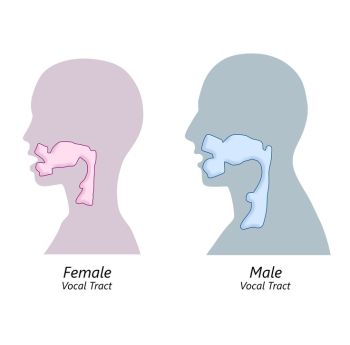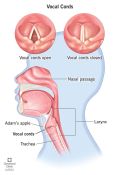Voice Production
Sound is air vibrations. Voice production depends on airflow, pitch, resonance and articulation.
Airflow: the diaphragm muscle pushes up on the lungs, pressuring air up through trachea. Strengthening it creates a more powerful/loud voice.
-
Voice producing systems
-
Vocal Cords

Pitch/Frequency: The vocal cords chop up the flow of air from the trachea by opening and closing at a frequency which depends on their size and how tense the muscle is. How fast the vibration happens will determine if it's a high or low pitch sound.
Resonance: Sound is amplified and modified by the vocal tract resonators like the throat, mouth cavity, and nasal passages. The resonators increase the loudness of certain frequencies and attenuate (decrease loudness) of other frequencies. When low frequencies are amplified it's considered "heavy" or "dark" resonance, and when high frequencies are amplified it's considered "light". Articulation: The vocal tract articulators like the tongue, soft palate, and lips modify the voiced sound. The articulators produce recognizable words. You can think of this as an accent or way of speaking.
Female Voice

The main difference between male and female voice is male voice has a lower pitch and heavy weight. Testosterone increases the length and thickness of the vocal cords and also the size of the entire vocal tract itself.
In order to sound more feminine you need to train to both increase pitch (by tensing your cords) and lighten resonance (by raising your larynx and maintaining mouth posture). https://www.youtube.com/watch?v=21ZfGPp-Ves
To achieve resonance you need to learn to use the muscles around your neck to force the larynx upwards and back in your throat which will decrease the length and width of your vocal tract, amplifying higher frequency sounds. http://lena.kiev.ua/voice/
To achieve pitch you need to practice controlling airflow while maintaining tense vocal cords without going into falsetto or running out of breath https://www.youtube.com/watch?v=BfCS01MkbIY
More Resources
For recording and visualizing your pitch and resonance https://acousticgender.space/

